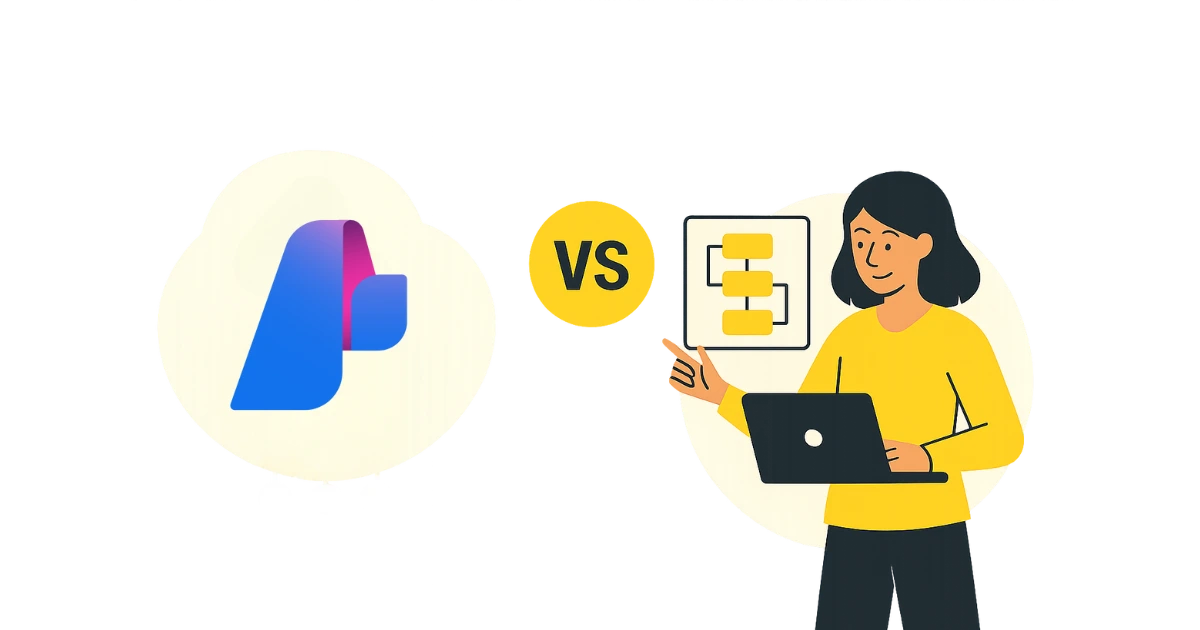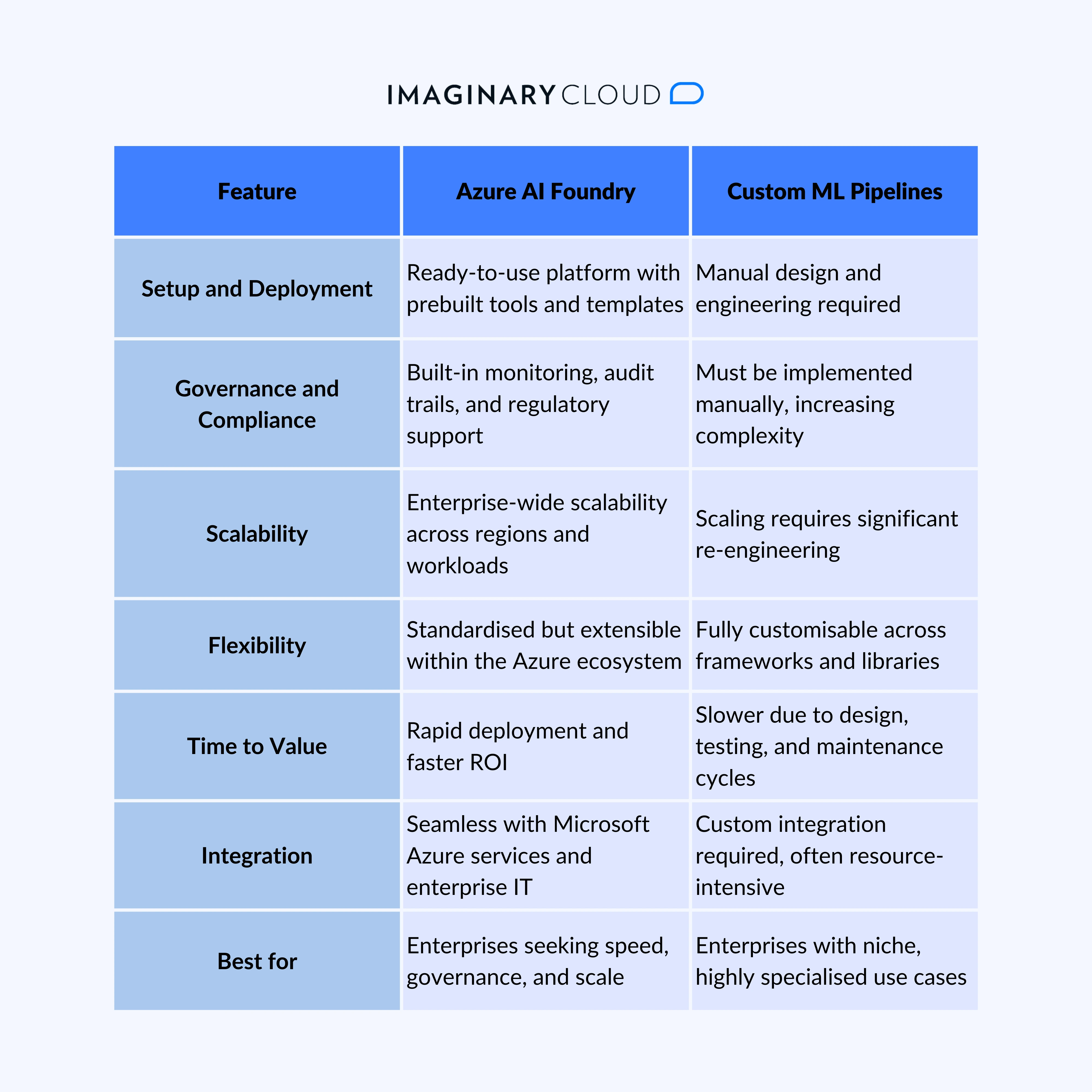contact us


Azure AI Foundry is Microsoft’s enterprise platform for managing the full AI lifecycle with speed, governance, and scale. Custom ML pipelines are bespoke workflows that provide flexibility and control but require significant engineering investment. Enterprises face a key choice: adopt Foundry or continue building custom pipelines.
Key benefits compared:
Azure AI Foundry is Microsoft’s unified platform for building, deploying, and managing AI applications at enterprise scale. It brings together tools for machine learning (ML), generative AI, and MLOps into one environment, designed to accelerate innovation while ensuring governance and security.
Azure AI Foundry helps enterprises overcome the limitations of fragmented AI workflows by offering a single, governed platform for scaling machine learning and generative AI. It reduces complexity, speeds up adoption, and ensures AI projects deliver measurable business value.
In summary: Azure AI Foundry centralises model tracking, access control, auditing, and compliance alignment (e.g., GDPR/ISO/HIPAA) to reduce risk and manual overhead. Custom pipelines can match this, but only with significant engineering effort and ongoing maintenance.
Custom machine learning (ML) pipelines are manually engineered workflows that guide data through every stage of the ML lifecycle, from ingestion and preprocessing to training, deployment, and monitoring. They give enterprises full control over their AI infrastructure but come with added complexity and overhead.
Enterprises deciding between Azure AI Foundry and custom ML pipelines must balance speed, governance, and scalability against flexibility and control. While Foundry offers a ready-to-use platform with built-in compliance, custom ML pipelines provide tailored architectures but demand greater investment.

Gartner predicts that “over 40% of agentic AI projects will be scrapped by the end of 2027 due to rising costs and unclear business value” — a reminder that over-customised, unmanaged approaches carry significant risk.
— Reuters covering Gartner
In summary: Choose Azure AI Foundry when speed, built-in governance, and enterprise-scale integration are priorities; choose custom ML pipelines when niche requirements demand bespoke architectures and full control. Foundry typically lowers time-to-value and TCO, while custom builds trade agility for flexibility.

Azure AI Foundry enables enterprises to operationalise AI at scale across industries. By combining machine learning, generative AI, and MLOps within one platform, it accelerates innovation while ensuring governance and compliance.
Accenture — multi-industry GenAI at speed
Carvana — AI agents for customer experience
Atomicwork — service-desk deflection with agentic AI
healow — patient contact at healthcare scale
Market proof (adoption signal)
Across these cases, the consistent lesson is that governed scale matters more than experimental speed. Enterprises that invested in observability, compliance, and integration within Azure AI Foundry achieved faster ROI and avoided the costly pitfalls of fragmented, custom-built AI pipelines.
Enterprises can adopt Azure AI Foundry incrementally, ensuring governance and scalability are embedded from the outset. A structured approach helps balance innovation with compliance.
Azure AI Foundry delivers a faster, more governed, and more scalable path to enterprise AI adoption than custom ML pipelines. While bespoke pipelines offer flexibility, they are costly to maintain and slow to scale. Foundry unifies the AI lifecycle — from data to deployment — making it the natural choice for enterprises seeking efficiency, compliance, and measurable ROI.
Next step: Don’t let fragmented AI workflows hold your organisation back.
Is Azure AI Foundry the same as Azure Machine Learning?
No. Azure Machine Learning is a specific service for model training and deployment, whereas Azure AI Foundry is the broader platform that unifies ML, generative AI, and governance in one workspace.
Can Azure AI Foundry replace existing ML pipelines?
In many cases, yes. Foundry streamlines model training, deployment, and monitoring. However, highly specialised use cases may still require custom ML pipelines for maximum flexibility.
How secure is Azure AI Foundry for enterprise data?
Azure AI Foundry is built on Microsoft Azure’s enterprise-grade security. It supports encryption, identity management, and compliance with GDPR, ISO, HIPAA, and other industry standards.
What is the cost of Azure AI Foundry compared to custom ML pipelines?
Costs vary by usage. Foundry reduces engineering overhead and accelerates time to value, making the total cost of ownership lower than custom ML pipelines, which require larger in-house teams and longer build times.
When should enterprises use custom ML pipelines instead of Foundry?
Custom pipelines remain useful when workflows require deeply tailored architectures, niche optimisation, or integration with legacy systems not easily supported by standard platforms.


Alexandra Mendes is a Senior Growth Specialist at Imaginary Cloud with 3+ years of experience writing about software development, AI, and digital transformation. After completing a frontend development course, Alexandra picked up some hands-on coding skills and now works closely with technical teams. Passionate about how new technologies shape business and society, Alexandra enjoys turning complex topics into clear, helpful content for decision-makers.
People who read this post, also found these interesting: